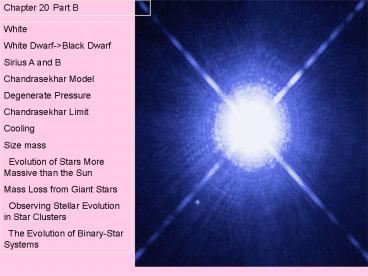PowerPoint Presentation Chapter 20 Opener PowerPoint PPT Presentation
1 / 17
Title: PowerPoint Presentation Chapter 20 Opener
1
Chapter 20 Part B
White White Dwarf-Black Dwarf Sirius A and
B Chandrasekhar Model Degenerate
Pressure Chandrasekhar Limit Cooling Size mass
Evolution of Stars More Massive than the Sun Mass
Loss from Giant Stars Observing Stellar
Evolution in Star Clusters The Evolution of
Binary-Star Systems
2
Evolution of White Dwarfs
NGC 2440
The Planetary Nebula NGC 2440, contains one of
the hottest white dwarf known. It no longer
has any nuclear fuel available to burn. However,
a white dwarf is still very hot from its past as
the core of a star.
As time passes, the white dwarf cools by
radiating its energy outward. The white dwarf
will eventually give up all its energy and become
a solid, crystal black dwarf. Old, cold white
dwarf Takes 10 11 yr to cool off Galaxy is not
old enough for there to be any Black Dwarfs yet.
3
Sirius Binary System
Sirius B is a white dwarf star, a companion to
Sirius A.
Sirius A
Sirius B
Sirius B, a white dwarf, is the first to be
discovered. Based on changes in its proper
motion, in 1844 Friedrich Wilhelm Bessel deduced
that Sirius had a hidden companion. Nearly two
decades later in 1862 Alvan Graham Clark
discovered the faint companion, which is called
Sirius B, or affectionately "the Pup".
Solar Units A B Mass
2 .98 Radius 1.7 .008 Temp
9.900, 25,200
4
Einstein's theory of General Relativity and
Serius B
Sirius B powerful gravitational field is
350,000 times greater than Earth's, a 150-pound
person would weigh 50 million pounds standing on
its surface. Einstein's theory of General
Relativity says that light loses energy when it
attempts to escape the gravity of a compact star.
Light from the white dwarf has to climb out of
this gravitational field and is stretched to
longer, redder wavelengths--- called
gravitational redshift
Mass .98
5
Stars that evolve into White Dwarfs
0.8M Density 105- 106 g/cc
One teaspoon of white dwarf weighs
Densities for Comparison WATER
1 g/cm3 LEAD
11 g/cm3 CORE OF SUN
150 g/cm3 WHITE DWARF 106 g/cm3
NEUTRON STAR 1015 g/cm3
WD
6
- Stars that evolve into White Dwarfs
- 0.8M
- Properties of White Dwarf
- MWD
- Radius Rearth (
- Density 105- 106 g/cc
- Escape Speed 2 speed of light
- No nuclear fusion or gravitational contraction.
It shines by residual heat.
Chandrasekhar 1910-1995
white dwarfs in the globular cluster M4
7
MO-Ne-Mg White Dwarfs
WHY DOESNT THE WHITE DWARF COLLAPSE??
Chandrasekhar 1910-1995
Main Sequence Star
No Energy Source
Energy Source
8
Pauli Exclusion Principle "No two electrons
can be in the same place at the same time.
Degenerate Pressure quantum theory prohibits
more than one electron from occupying the same
state.
9
Degenerate Pressure Densely packet
electrons are like a crowded parking lot. All
the "parking spaces" are full. For gravity to
compress the white dwarf anymore, it must force
electrons where they cannot go. Once a star is
degenerate, gravity cannot compress it any more
because quantum mechanics tells us there is no
more available space to be taken up. So our white
dwarf survives, not by internal combustion, but
by quantum mechanical principles that prevent its
collapse.
10
Mass --------- Radius
Chandrasekhar Mass Limit
Maximum Mass for White Dwarf Mch 1.4
Msun First calculated by Chandrasekhar in the
1930s. Above this mass the pressure becomes so
high that electrons and protons combine to form
neutrons throughout the object---
p e- ? n ne
--- electron degeneracy pressure fails the
star collapses.
11
Only high mass stars can fuse heavy nuclei. This
is because high temperatures are required to
overcome the coulomb potential and support the
core with fewer nuclei.
Fuel Product Temp. needed
Minimum mass H He
4x106 K 0.1 solar mass He
C, O 12x107 K
0.4 solar masses C Ne, Na, Mg, O
60x107 K 4 solar masses Si
Ni to Fe 3x109 K
8 solar masses
12
Table 20-3End Points of Evolution for Stars of
Different Masses
13
The Evolution of Close Binary-Star Systems
Each star is surrounded by its own Roche lobe
particles inside the lobe belong to the central
star. The Lagrangian point is where the
gravitational forces are equal.
14
Types of Binaries
Detached binary There is no physical contact
between the both stars. None has filled it's
Roche lobe and they are both spherical in shape
(unless one or both of them rotate really fast).
Semi-detached binary One of the stars has
filled its Roche lobe and has a shape which
resembles an egg - due to the gravitational
distortion of the massive star
Contact binary In this case, both stars fill
their Roche lobes, and may have become slightly
egg-shaped. In this case the stars are relatively
close to each other.
15
Light Curves
Algol. (semi-detached)
- W UMa. (contact or over-contact)
16
Algol Evolution
Initially, Algol was probably a detached binary
made up of two main-sequence stars a relatively
massive blue giant and a less massive companion
similar to the Sun.
As the more massive component (star 1) left the
main sequence, it expanded to fill, and
eventually overflow, its Roche lobe, transferring
large amounts of matter onto its smaller
companion (star 2).
Today, star 2 is the more massive of the two, but
it is on the main sequence. Star 1 is still in
the subgiant phase and fills its Roche lobe,
causing a steady stream of matter to pour onto
its companion.
17
End of Chapter 20 Stellar Evolution Part b
Go to Chapter 21 Stellar Explosions

